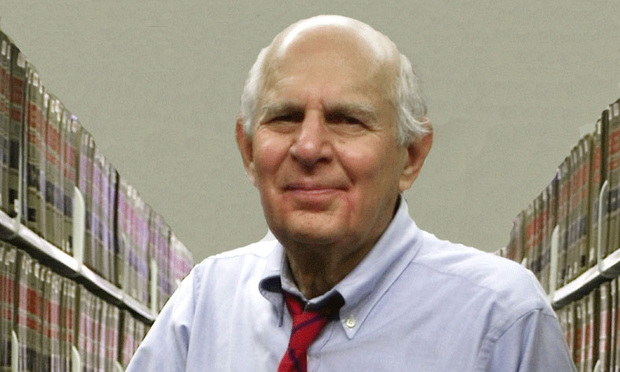The SECURE Act: Charitable Gift Implications
The SECURE Act kills the stretch IRA for most heirs. Until this new legislation, an heir could generally have required minimum distributions stretched over his or her life expectancy. And that minimized taxes—plus the assets in the heir's IRA grew tax-free until withdrawn. In his Estate Planning and Philanthropy column, Conrad Teitell discusses the ramifications of the Act's changes.
February 21, 2020 at 12:45 PM
5 minute read
 Conrad Teitell
Conrad Teitell
The SECURE1 Act kills the stretch IRA for most heirs. Until this new legislation, an heir could generally have required minimum distributions stretched over his or her life expectancy. And that minimized taxes—plus the assets in the heir's IRA grew tax-free until withdrawn.
Highlights of the new law:
- Required Minimum Distributions start at age 72 (up from 70½).
- Most heirs' IRA payments can't be stretched out for more than 10 years.
- But these beneficiaries (with some qualifications) qualify for "life-expectancy" IRA payments: (1) the IRA owner's surviving spouse; (2) her or his minor child; (3) disabled beneficiaries; (4) chronically ill individuals; and (5) individuals who aren't more than 10 years younger than the deceased IRA owner.
Among other provisions, the SECURE Act:
- Repeals the prohibition on contributions to a traditional IRA by an individual who has attained age 70½.
- Allows long-term part-time workers to participate in 401(k) Plans.
- Allows penalty-free withdrawals from retirement plans up to $5,000 per individual for any "qualified birth or adoption distributions."
- Expands 529 education savings accounts to cover costs associated with registered apprenticeships and up to $10,000 of qualified student loan repayments (including those for siblings).
Drum roll—enter the CHIPS IRA2 (Charity Heirs Income Plan Stretch IRA): Working around the 10-year stretch IRA limitations using charitable remainder trusts:
- Taxwell Smart provides that on his death a charitable remainder unitrust (meeting all the CRUT requirements—e.g., payout of at least 5%, 10% minimum charitable remainder interest) pay his grandchild for life or term of years (not exceeding 20 years). This will save estate taxes (estate tax charitable deduction for value of charitable remainder interest) for Mr. Smart if he's subject to that tax.
- Whether Taxwell is or isn't subject to the estate tax, the transfer of his IRA at his death to fund the CRUT won't subject the heir to tax on Income in Respect of a Decedent (IRD). Payments to the grandchild will be taxable under the four-category taxation regime. And a charitable gift is made at the trust term's end.
- Keep in mind that the Stretch CRT has to pass the 10% minimum remainder interest requirement. For younger heirs, the stretch can't be for life but will be for a term of years (not exceeding 20 years). And for CRATs, the trust must also pass the 5% probability test of Rev. Rul. 77-374.
- No surprise, charitable intent is important. The cost of generosity is reduced by the tax savings to the heir who can have IRA payments stretched more than 10 years.
Giving an heir an income tax charitable deduction:
- Suppose Taxwell's grandson is a successful farmer growing hedge funds in Greenwich, Conn. Grandson Hedgely is already rich beyond the wildest dreams of avarice.
Nevertheless, Taxwell creates a testamentary CRUT for Hedgely with his IRA. Several years go by and Hedgely concludes he really doesn't need the CRUT payments. So he gives his remaining life interest to the named qualified public charitable remainder organization (or qualified public charity that Hedgely has named if he has been given that power). Hedgely will then get an income tax charitable deduction for the then value of his life interest. Taxwell has, in effect, given Hedgely an income tax charitable deduction.
Hedgely on his own figured out how to benefit a charity during the term of his CRUT life interest and get an income tax charitable deduction.
- Suppose Taxwell's estate is subject to the estate tax. On his deathbed he tells Hedgely that he's creating a testamentary CRUT for him funded with Taxwell's IRA. Taxwell extracts Hedgely's promise that he'll give his remaining life interest to the named publicly supported charitable remainder organization within two years of Taxwell's death.
If IRS Agent Seigfried learns of this, he could well deny Taxwell's estate an estate tax charitable deduction for the charitable remainder interest; and collect IRD tax from Hedgely. Taxwell and Hedgely had better talk about this in a motel room with the water running.
Parthian shot. Will the age for taking required minimum distributions (RMDs) now age 72 (instead of 70½) keep donors (ages 70½ to 71) from making charitable distributions from their IRAs until age 72?
Time will tell. Remember, distributions from IRAs when the RMD age was 70½ qualified as QCDs even though they weren't RMDs. So donors can still at ages 70½ to 71 make charitable gifts from their IRAs.
Endnotes:
- Setting Every Community Up for Retirement Enhancement Act (effective 1/1/20). The U.S. Bureau of Acronyms must have worked overtime and had to stretch to come up with this acronym.
- How I came up with the CHIPS acronym: Many long showers—where I do my best thinking—didn't help. But then, it hit me while marathon TV football viewing with two grandsons over the holidays. We consumed bushels of CHIPS. Simply put, Charities and Heirs will be in the CHIPS using Income Plans to Stretch heirs' IRA payments. And that's my story—and I'm sticking to it.
Conrad Teitell is a principal at Cummings & Lockwood in Stamford, Conn.
This content has been archived. It is available through our partners, LexisNexis® and Bloomberg Law.
To view this content, please continue to their sites.
Not a Lexis Subscriber?
Subscribe Now
Not a Bloomberg Law Subscriber?
Subscribe Now
NOT FOR REPRINT
© 2025 ALM Global, LLC, All Rights Reserved. Request academic re-use from www.copyright.com. All other uses, submit a request to [email protected]. For more information visit Asset & Logo Licensing.
You Might Like
View All


Judgment of Partition and Sale Vacated for Failure To Comply With Heirs Act: This Week in Scott Mollen’s Realty Law Digest
Trending Stories
- 1Uber Files RICO Suit Against Plaintiff-Side Firms Alleging Fraudulent Injury Claims
- 2The Law Firm Disrupted: Scrutinizing the Elephant More Than the Mouse
- 3Inherent Diminished Value Damages Unavailable to 3rd-Party Claimants, Court Says
- 4Pa. Defense Firm Sued by Client Over Ex-Eagles Player's $43.5M Med Mal Win
- 5Losses Mount at Morris Manning, but Departing Ex-Chair Stays Bullish About His Old Firm's Future
Who Got The Work
J. Brugh Lower of Gibbons has entered an appearance for industrial equipment supplier Devco Corporation in a pending trademark infringement lawsuit. The suit, accusing the defendant of selling knock-off Graco products, was filed Dec. 18 in New Jersey District Court by Rivkin Radler on behalf of Graco Inc. and Graco Minnesota. The case, assigned to U.S. District Judge Zahid N. Quraishi, is 3:24-cv-11294, Graco Inc. et al v. Devco Corporation.
Who Got The Work
Rebecca Maller-Stein and Kent A. Yalowitz of Arnold & Porter Kaye Scholer have entered their appearances for Hanaco Venture Capital and its executives, Lior Prosor and David Frankel, in a pending securities lawsuit. The action, filed on Dec. 24 in New York Southern District Court by Zell, Aron & Co. on behalf of Goldeneye Advisors, accuses the defendants of negligently and fraudulently managing the plaintiff's $1 million investment. The case, assigned to U.S. District Judge Vernon S. Broderick, is 1:24-cv-09918, Goldeneye Advisors, LLC v. Hanaco Venture Capital, Ltd. et al.
Who Got The Work
Attorneys from A&O Shearman has stepped in as defense counsel for Toronto-Dominion Bank and other defendants in a pending securities class action. The suit, filed Dec. 11 in New York Southern District Court by Bleichmar Fonti & Auld, accuses the defendants of concealing the bank's 'pervasive' deficiencies in regards to its compliance with the Bank Secrecy Act and the quality of its anti-money laundering controls. The case, assigned to U.S. District Judge Arun Subramanian, is 1:24-cv-09445, Gonzalez v. The Toronto-Dominion Bank et al.
Who Got The Work
Crown Castle International, a Pennsylvania company providing shared communications infrastructure, has turned to Luke D. Wolf of Gordon Rees Scully Mansukhani to fend off a pending breach-of-contract lawsuit. The court action, filed Nov. 25 in Michigan Eastern District Court by Hooper Hathaway PC on behalf of The Town Residences LLC, accuses Crown Castle of failing to transfer approximately $30,000 in utility payments from T-Mobile in breach of a roof-top lease and assignment agreement. The case, assigned to U.S. District Judge Susan K. Declercq, is 2:24-cv-13131, The Town Residences LLC v. T-Mobile US, Inc. et al.
Who Got The Work
Wilfred P. Coronato and Daniel M. Schwartz of McCarter & English have stepped in as defense counsel to Electrolux Home Products Inc. in a pending product liability lawsuit. The court action, filed Nov. 26 in New York Eastern District Court by Poulos Lopiccolo PC and Nagel Rice LLP on behalf of David Stern, alleges that the defendant's refrigerators’ drawers and shelving repeatedly break and fall apart within months after purchase. The case, assigned to U.S. District Judge Joan M. Azrack, is 2:24-cv-08204, Stern v. Electrolux Home Products, Inc.
Featured Firms
Law Offices of Gary Martin Hays & Associates, P.C.
(470) 294-1674
Law Offices of Mark E. Salomone
(857) 444-6468
Smith & Hassler
(713) 739-1250







